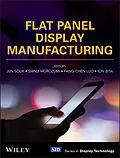An extensive introduction to the engineering and manufacture of current and next-generation flat panel displays
This book provides a broad overview of the manufacturing of flat panel displays, with a particular emphasis on the display systems at the forefront of the current mobile device revolution. It is structured to cover a broad spectrum of topics within the unifying theme of display systems manufacturing. An important theme of this book is treating displays as systems, which expands the scope beyond the technologies and manufacturing of traditional display panels (LCD and OLED) to also include key components for mobile device applications, such as flexible OLED, thin LCD backlights, as well as the manufacturing of display module assemblies.
Flat Panel Display Manufacturing fills an important gap in the current book literature describing the state of the art in display manufacturing for today's displays, and looks to create a reference the development of next generation displays. The editorial team brings a broad and deep perspective on flat panel display manufacturing, with a global view spanning decades of experience at leading institutions in Japan, Korea, Taiwan, and the USA, and including direct pioneering contributions to the development of displays. The book includes a total of 24 chapters contributed by experts at leading manufacturing institutions from the global FPD industry in Korea, Japan, Taiwan, Germany, Israel, and USA.
* Provides an overview of the evolution of display technologies and manufacturing
* Treats display products as systems with manifold applications, expanding the scope beyond traditional display panel manufacturing to key components for mobile devices and TV applications
* Provides a detailed overview of LCD manufacturing, including panel architectures, process flows, and module manufacturing
* Provides a detailed overview of OLED manufacturing for both mobile and TV applications, including a chapter dedicated to the young field of flexible OLED manufacturing
* Provides a detailed overview of the key unit processes and corresponding manufacturing equipment, including manufacturing test & repair of TFT array panels as well as display module inspection & repair
* Introduces key topics in display manufacturing science and engineering, including productivity & quality, factory architectures, and green manufacturing
Flat Panel Display Manufacturing will appeal to professionals and engineers in R&D departments for display-related technology development, as well as to graduates and Ph.D. students specializing in LCD/OLED/other flat panel displays.
Autorentext
JUN SOUK, PHD is a Professor in the Department of Electronic Engineering, Hanyang University, South Korea.
SHINJI MOROZUMI, PHD is the founder and chairman of Crystage Inc., Japan.
FANG-CHEN LUO, PHD is advisor to the President and Fellow of AU Optronics, Taiwan.
ION BITA, PHD leads development of display technologies and components at Apple Inc., USA.
Inhalt
List of Contributors xxi
Series Editor's Foreword xxv
Preface xxvii
1 Introduction 1
FangChen Luo, Jun Souk, Shinji Morozumi, and Ion Bita
1.1 Introduction 1
1.2 Historic Review of TFTLCD Manufacturing Technology Progress 1
1.2.1 Early Stage TFT and TFTBased Displays 2
1.2.2 The 1990s: Initiation of TFTLCD Manufacturing and Incubation of TFTLCD Products 2
1.2.3 Late 1990s: Booming of LCD Desktop Monitor and Wide Viewing Angle Technologies 4
1.2.4 The 2000s: A Golden Time for LCDTV Manufacturing Technology Advances 4
1.3 Analyzing the Success Factors in LCD Manufacturing 5
1.3.1 Scaling the LCD Substrate Size 7
1.3.2 Major Milestones in TFTLCD Manufacturing Technology 9
1.3.2.1 First Revolution: AKT Cluster PECVD Tool in 1993 9
1.3.2.2 Second Revolution: Wide Viewing Angle Technology in 1997 9
1.3.2.3 Third Revolution: LC Drop Filling Technology in 2003 10
1.3.3 Major Stepping Stones Leading to the Success of Active Matrix Displays 10
References 11
2 TFT Array Process Architecture and Manufacturing Process Flow 13
Chiwoo Kim
2.1 Introduction 13
2.2 Material Properties and TFT Characteristics of aSi, LTPS, and Metal Oxide TFTs 15
2.2.1 aSi TFT 15
2.2.2 LTPS TFT 16
2.2.2.1 Excimer Laser Annealing (ELA) 17
2.2.3 Amorphous Oxide Semiconductor TFTs 22
2.3 aSi TFT Array Process Architecture and Process Flow 22
2.3.1 FourMask Count Process Architecture for TFTLCDs 24
2.4 PolySi TFT Architecture and Fabrication 27
2.5 Oxide Semiconductor TFT Architecture and Fabrication 30
2.6 TFT LCD Applications 32
2.7 Development of SLSBased System on Glass Display [1, 11, 14, 15] 33
References 35
3 Color Filter Architecture, Materials, and Process Flow 39
Young Seok Choi, Musun Kwak, and Youn Sung Na
3.1 Introduction 39
3.2 Structure and Role of the Color Filter 39
3.2.1 Red, Green, and Blue (RGB) Layer 40
3.2.1.1 Color Coordinate and Color Gamut 41
3.2.2 Black Matrix 44
3.2.3 Overcoat and Transparent Electrode 45
3.2.4 Column Spacer 46
3.3 Color Filter Manufacturing Process Flow 46
3.3.1 Unit Process 46
3.3.1.1 Formation of Black Matrix 46
3.3.1.2 Formation of RGB Layer 48
3.3.1.3 Overcoat (OC) 51
3.3.1.4 Formation of ITO Electrodes 53
3.3.1.5 Column Spacer (Pattern Spacer) 53
3.3.2 Process Flow for Different LC Mode 54
3.3.2.1 Color Filter for the TN Mode 54
3.3.2.2 Color Filter for the IPS Mode 54
3.3.2.3 Color Filter for the VA Mode 55
3.4 New Color Filter Design 55
3.4.1 White Color (Four Primary Colors) Technology 55
3.4.2 Color Filter on TFT 56
References 57
4 Liquid Crystal Cell Process 59
HeungShik Park and KiChul Shin
4.1 Introduction 59
4.2 Liquid Crystal Cell Process 59
4.2.1 Alignment Layer Treatment 61
4.2.2 Process of Applying PI Layers 62
4.2.3 Rubbing Process 63
4.2.4 PhotoAlignment Process 64
4.2.5 LC Filling Process 65
4.2.5.1 Vacuum Filling Method 66
4.2.5.2 End Seal Process 66
4.2.5.3 One Drop Filling (ODF) Method 67
4.2.6 Vacuum Assembly Process 68
4.2.7 Polarizer Attachment Process 69
4.3 Conclusions 70
Acknowledgments 70
References 70
5 TFTLCD Module and Package Process 73
Chun Chang Hung
5.1 Introduction 73
5.2 Driver IC Bonding: TAB and COG 73
5.3 Introduction to LargePanel JI Process 74
5.3.1 COF Bonding 75
5.3.1.1 Edge Clean 75
5.3.1.2 ACF Attachment 76
5.3.1.3 COF PreBonding ...
